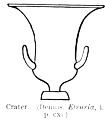Crater
(
κρατήρ; Ionic
κρητήρ;
Lat.
crater or
cratera, from
κεράννυμι, “to mix”). A vessel in which the wine, according
to the custom of the ancients, who very seldom drank it undiluted, was mixed with water, and
from which the cups were filled. In the Homeric Age the mixture was always made in the
dining-room by heralds or young men (
κοῦροι). The use
of the vessel is sufficiently clear from the expressions so frequent in the poems of Homer:
κρητῆρα κεράσασθαι—i. e.
οἶνον καὶ ὕδωρ ἐν κρητῆρι μίσγειν:
πίνειν
κρητῆρα, “to empty the crater”;
κρητῆρα
στήσασθαι (
cratera statuere), “to place the filled
crater near the table”;
κρητῆρας ἐπιστέφεσθαι
ποτοῖο, “to fill the craters to the
 |
|
Crater. (Dennis. Etruria , i. p. cxi.)
|
brim.” The crater, in the Homeric Age, was generally of silver, sometimes
with a gold edge, and sometimes all gold or gilt. It stood upon a tripod, and its ordinary
place in the
μέγαρον was in the most honourable part of the
room, at the farthest end from the entrance, and near the seat of the most distinguished among
the guests. The size of the crater seems to have varied according to the number of guests, for
where their number is increased a larger crater is asked for. It would seem, at least at a
later period (for in the Homeric poems we find no traces of the custom), that three craters
were filled at every feast after the tables were removed. According to Suidas, the first was
dedicated to Hermes, the second to Charisius, and the third to Zeus Soter; but others called
them by different names; thus the first, or, according to others, the last, was also
designated the
κρατὴρ ἀγαθοῦ δαίμονος, “the
crater of the good genius,”
κρατὴρ ὑγιείας and
μετανιπτρίς or
μετάνιπτρον,
because it was the crater from which the cups were filled after the washing of the hands.
There were special craters named from places, e. g. Lesbian, Laconian, Argive (
Herod.iv. 152).
Craters were among the first things on the embellishment of which the ancient artists
exercised their skill. Homer mentions, among the prizes proposed by Achilles, a beautifully
wrought silver crater, the work of the ingenious Sidonians, which, by the elegance of its
workmanship, excelled all others on the whole earth. In the reign of Croesus, king of Lydia,
the Lacedaemonians sent to that king a brazen crater, the border of which was all over
ornamented with figures (
ζώδια), and which was of such an
enormous size that it contained 300 amphorae. Croesus himself dedicated to the Delphic god two
huge craters, which the Delphians believed to be the work of Theodorus of Samos, and Herodotus
was induced, by the beauty of their workmanship, to think the same. It was
 |
|
Crater. (Dennis, Etruria , i. p. cxii.)
|
about Ol. 35 that the Samians dedicated six talents (the tenth of the profits made
by Colaeus on his voyage to Tartessus) to Heré, in the shape of an immense brazen
crater, the border of which was adorned with projecting heads of griffins.
This crater, which Herodotus calls Argive (from which we must infer that the Argive artists
were celebrated for their craters), was supported by three colossal brazen statues, seven
yards high, with their knees closed together.
The number of craters dedicated in temples seems everywhere to have been very great. Livius
Andronicus, in his
Equus Troianus, represented Agamemnon returning from Troy
with no less than 3000 craters, and Cicero says that Verres car
 |
|
Bronze Crater from Pompeii. (Overbeck.)
|
ried away from Syracuse the most beautiful brazen craters, which most probably
belonged to the various temples of that city. But craters were not only dedicated to the gods
as
anathemata, but were used on various solemn occasions in their
service. In sacrifices the libation was always taken from a crater; and sailors, before they
set out on their journey, used to take the libation with cups from a crater and pour it into
the sea. The name crater was also sometimes used as synonymous with
σιτλίον,
situla, a pail in which water was carried.
The Romans used their
crater or
cratera for the
same purposes for which it was used in Greece; but the most elegant specimens were, like most
works of art, made by Greeks. See
Caelatura.







